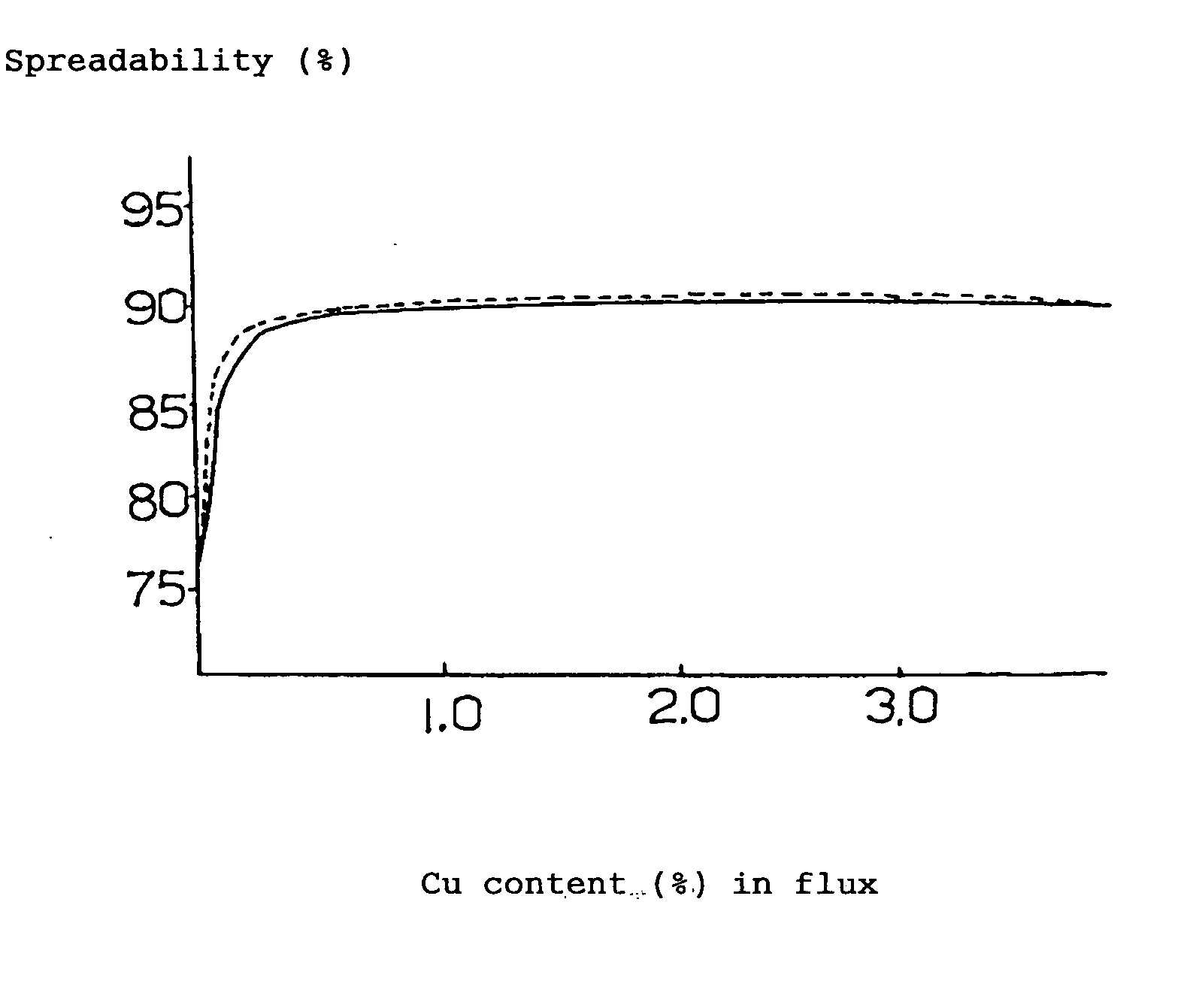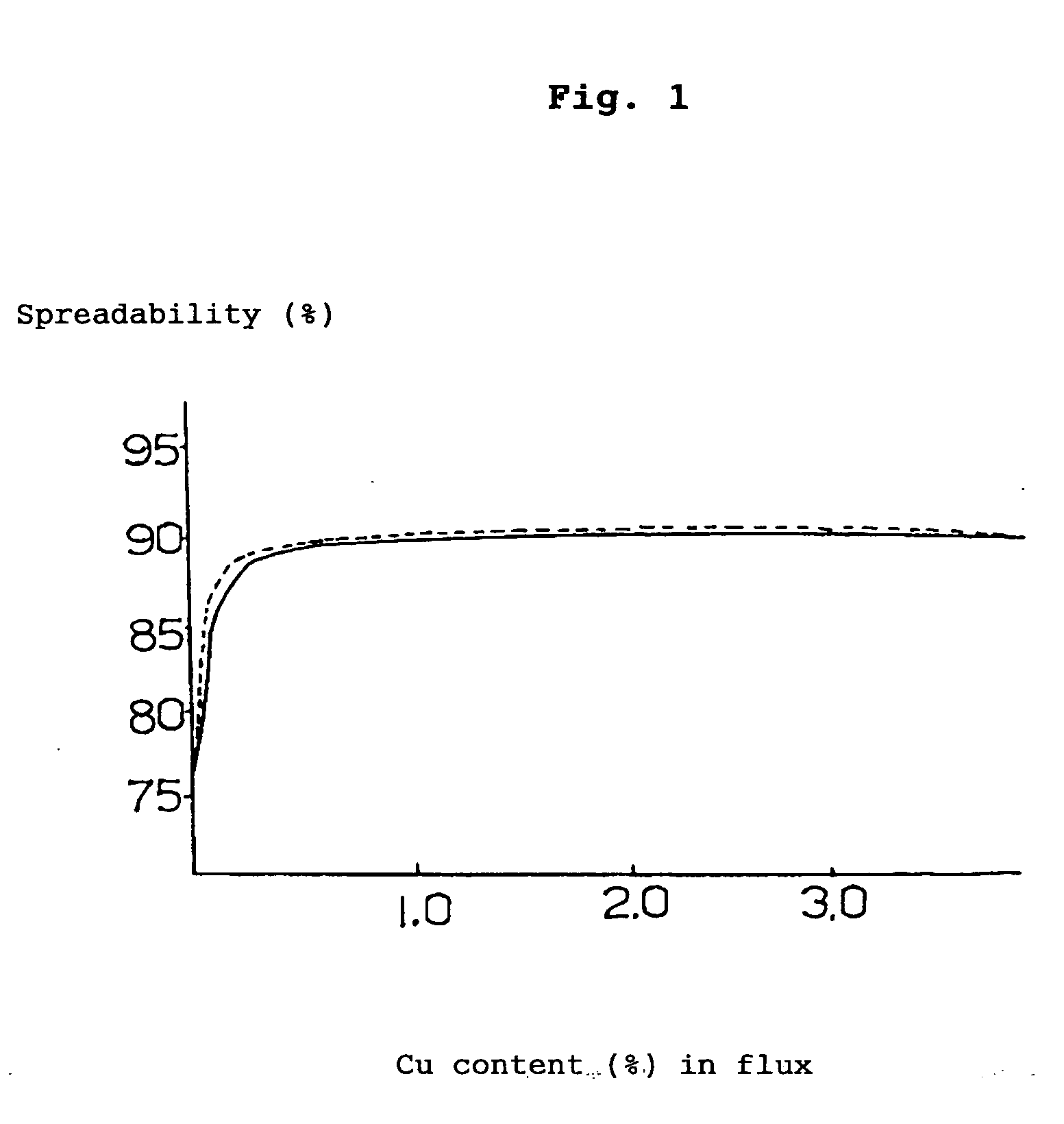Preflux, flux, solder paste and method of manufacturing lead-free soldered body
a technology of flux and solder paste, applied in the direction of manufacturing tools, non-metallic protective coating applications, solvents, etc., can solve the problems of inability to achieve inability to realize the same degree of productivity and reliability, soldering loss, etc., to improve improve the effect of wettability and soldering strength, and reduce the content of activating agents
- Summary
- Abstract
- Description
- Claims
- Application Information
AI Technical Summary
Benefits of technology
Problems solved by technology
Method used
Image
Examples
example 1
[0079] Various kinds of fluxes were prepared and by making use of them, the wettability of various kinds of metal compounds was compared with each other.
[0080] 19% (mass %, the same hereinafter) of rosin, 5% of polymerized rosin, 1% of ethylene amine hydrobromate (activating agent), 3% of various kinds of metal compounds (calculated as metal) and the balance of ethyl alcohol (100% in total) were mixed together and stirred to obtain a flux. By making use of this flux, solder spreadability test (the flux was coated on the surface of a copper-clad laminate to form a layer of flux on which a fused solder was applied drop-wise to measure the spreadability (%) of the solder) was performed based on JIS-Z-3197, the results being illustrated as follows.
[0081] By the way, the following (A) to (E) represent the compositions of the solders shown below.
(A) 96.5Sn-3.0Ag-0.5Cumelting point:217°C.(B) 99.3Sn-0.7Cumelting point:227°C.(C) 96.5Sn-3.5Agmelting point:221°C.(D) 91.2Sn-8.8Znmelting poi...
example 2
[0085] Examples of prefluxes for printed wiring board will be explained. The prefluxes employed herein can be said as an anti-rusting agent.
[0086] Prefluxes formed of a 20% ethyl alcohol solution of the following compounds were prepared and then a copper plate was dipped in each of prefluxes and then dried. The copper plates were left to stand for 96 hours under the conditions of: 40° C. in temperature and 95% in relative humidity to visually observe the discoloration of copper plates. Then, by making use of the lead / zinc-free solder (A) of Example 1, solder spreadability test (solid flux was placed on the surface of copper plate and then a flux was coated thereon and heated to measure the spreadability (%) of the fused solder) was performed based on JIS-Z-3197, the results being illustrated as follows.
[0087] By the way, the flux employed was prepared by mixing, with stirring, 19% of rosin, 5% of polymerized rosin, 1% of ethylene amine hydrobromate (activating agent), and the bala...
example 3
[0089] One example where a flux was applied to a solder paste will be explained.
[0090] 55% of rosin, 6% of hydrogenated caster oil (thixotropic agent), 1% of diphenyl guanidine (activating agent), 0.5% of 2,3-dibrome succinic acid, 0.3% of dimethyl amine hydrochloride, 5% of amine copper chloride complex (aniline copper chloride complex), 1% of nickel dimethylglyoxime, and the balance of carbitol (100% in total) were mixed together and stirred to obtain a flux.
[0091] 10% of this flux and 90% of lead / zinc-free solder powder (96.5Sn-3.0Ag-0.5Cu)(10-50 μm in particle diameter) were kneaded together to obtain a solder paste. This solder paste was substantially free from changes in viscosity with time and hence excellent in storage stability.
[0092] When this solder paste was subjected to a spreadability test in the same manner as in Example 1, this solder paste was found more excellent in wettability and bonding strength as compared with those of a solder paste (comparative example) w...
PUM
| Property | Measurement | Unit |
|---|---|---|
| temperature | aaaaa | aaaaa |
| temperature | aaaaa | aaaaa |
| softening point | aaaaa | aaaaa |
Abstract
Description
Claims
Application Information
 Login to View More
Login to View More - R&D
- Intellectual Property
- Life Sciences
- Materials
- Tech Scout
- Unparalleled Data Quality
- Higher Quality Content
- 60% Fewer Hallucinations
Browse by: Latest US Patents, China's latest patents, Technical Efficacy Thesaurus, Application Domain, Technology Topic, Popular Technical Reports.
© 2025 PatSnap. All rights reserved.Legal|Privacy policy|Modern Slavery Act Transparency Statement|Sitemap|About US| Contact US: help@patsnap.com



